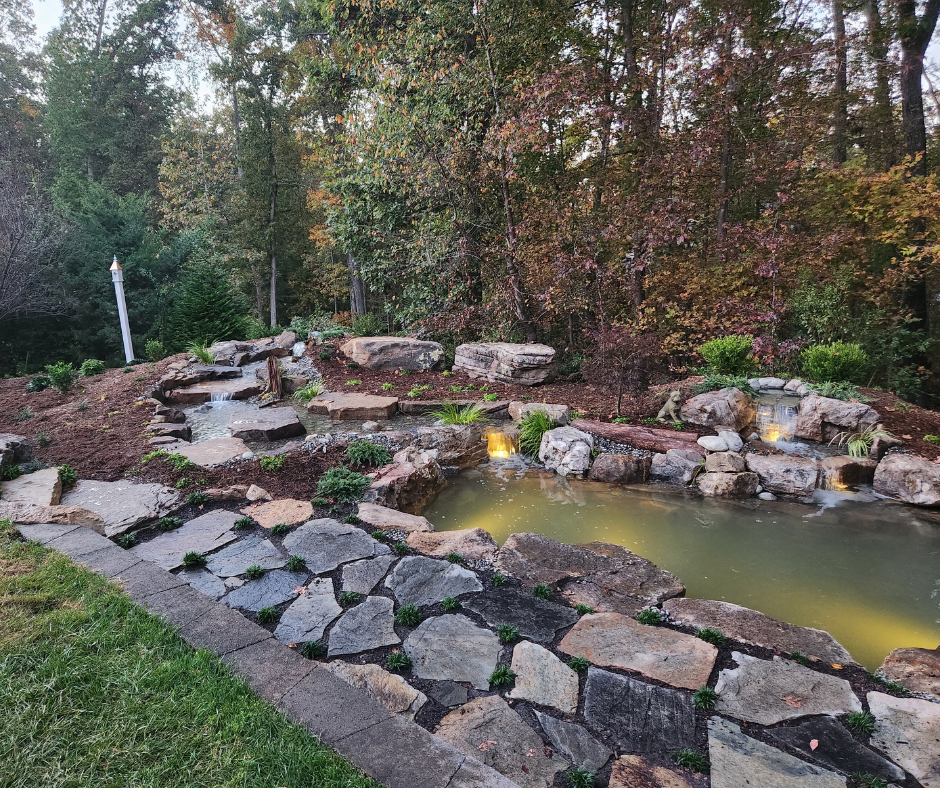A Backyard Pond Revival in Marvin, NC – From Forgotten to Fabulous
This Pond Caught the Attention of Greg Wittstock, The Pond Guy
After seeing photos and videos of the finished pond on social media, Greg Wittstock—also known as The Pond Guy—made a special trip all the way from his home base to check it out in person. He filmed an entire vlog on-site, capturing the craftsmanship, the homeowners’ reactions, and the story behind the build. Keep an eye out for the full video, set to be released on the Greg Wittstock, The Pond Guy YouTube channel in October 2025!
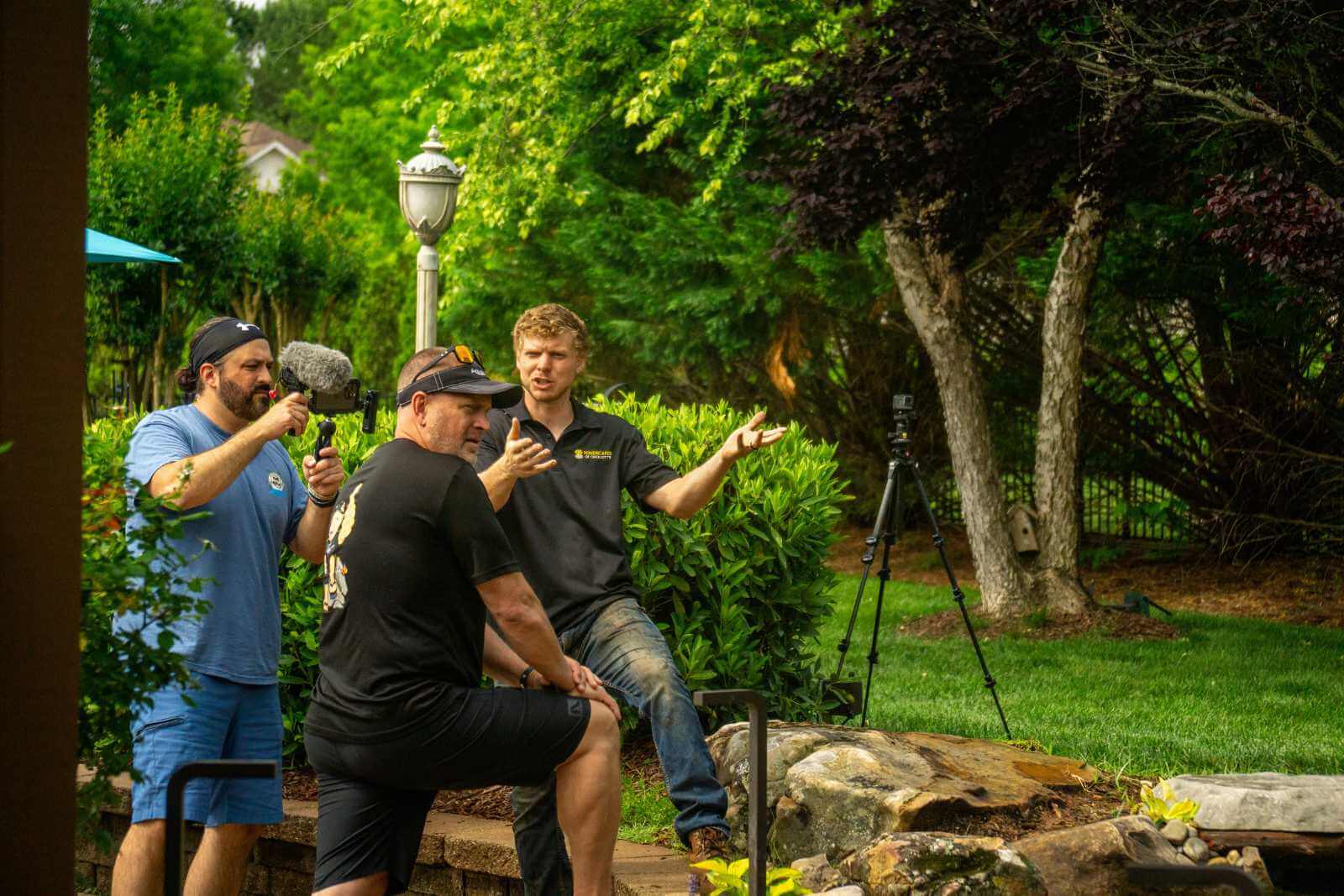
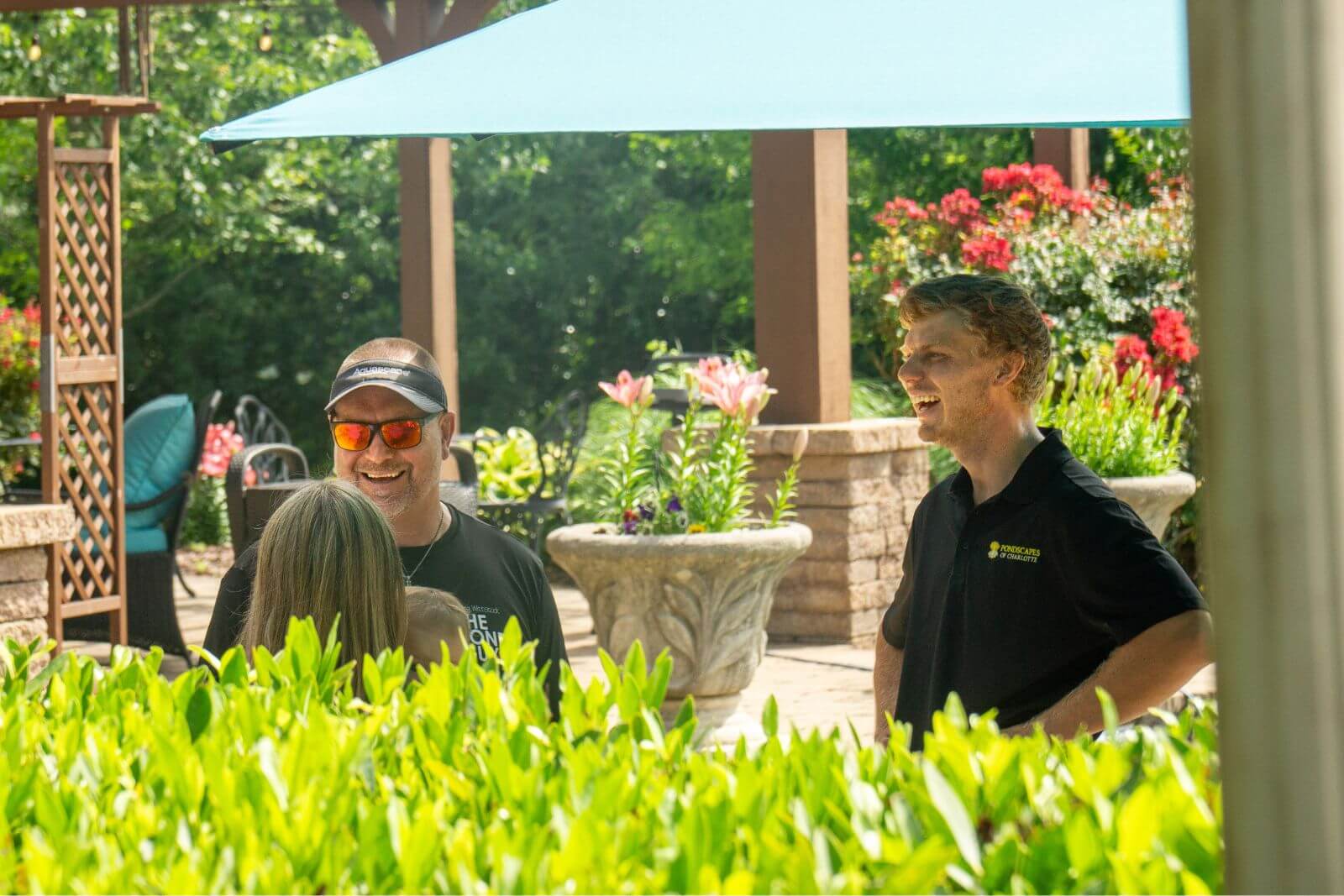
📞 A Call for Help from a New Homeowner
Robert and his family purchased a beautiful home in Marvin, North Carolina, with a stunning yard—but the pond was neglected and appeared to have been out of operation for years.
While researching online, he came across Pondscapes of Charlotte and filled out our contact form.
After reviewing his photos and discussing the pond’s condition, we determined that an exploratory cleanout wouldn’t be enough. The pond needed a complete renovation to truly complement his backyard.
We explored different design options using our pond gallery and matched them with estimated pricing to find the best fit.
Once we had a solid idea of the project’s size and cost, Robert invited me out for an on-site consultation!
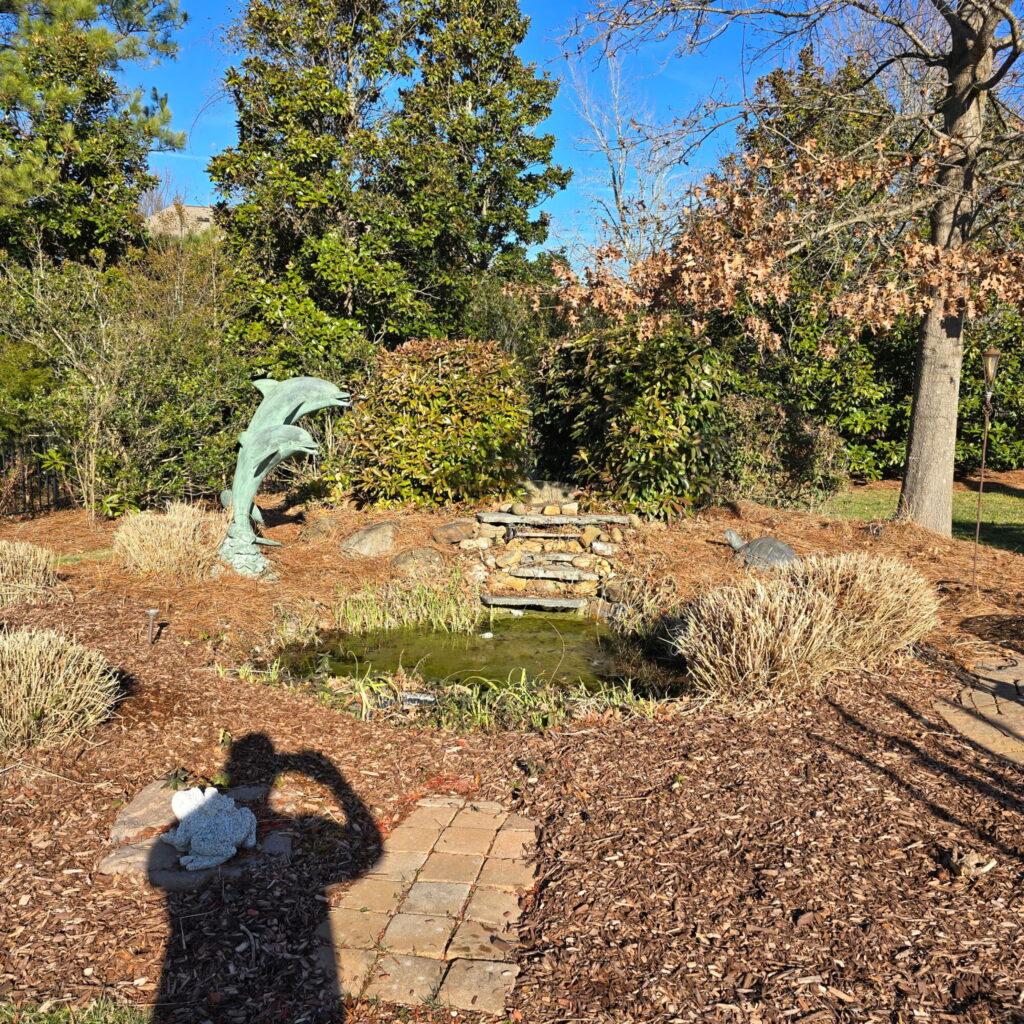
Consultation Design Phase
After speaking on the phone, we determined that his existing pond wasn’t worth repairing, and he decided to completely rebuild it instead. We discussed his vision for the new water feature, including the desired size and budget. Once we agreed on a general scope of work and price range, he invited me to his home for an on-site consultation with a $250 fee, which I explained would be credited toward the project if he chose to move forward.
During the consultation, we developed an incredible design, but it ended up being larger than what we initially discussed. I let him know I’d need to go back and recalculate the numbers due to the increased project size. He paid the consultation fee, and later that week, I sent him the finalized design along with the contract. To secure his spot on the schedule, he needed to sign the contract and submit a 50% deposit. When he did, I applied the $250 consultation fee toward his deposit, and we got started!
Hand Picking The Stone
For this project, we needed large boulders to create the elevation necessary for the waterfalls. We wanted to source the nicest boulders possible, so my dad and I took a trip to Virgil Reed Stone Quarries in the Appalachian Mountains of Tennessee.
By making the trip ourselves, we were able to hand-select the best stones, getting first pick as they came off the mountain. Often, by the time stone reaches Charlotte’s stone yards, many of the most unique and visually appealing boulders have already been chosen. To ensure we had exactly what we needed, we tagged 24 tons of boulders and arranged for delivery.
In addition to the main rock selection, we carefully picked out special pieces, including a large seating boulder and stepping stones to create a natural crossing over the pond. This extra effort ensured that every stone in the project contributed to both the beauty and functionality of the water feature.
The Project Begins!
After receiving a signed contract and a 50% deposit, we were able to schedule a start date for the project. Before breaking ground, we called 811, a free service that marks underground utility lines to ensure safe digging.
On the first day, our crew introduced themselves, and we reviewed the project scope with the homeowner one final time before getting to work. We began by removing the old pond, clearing out all the existing stone, and then excavating for the new design. With the site prepped, we were ready to bring the vision to life!
Excavation, Liner & Underlayment
We excavated the pond down to 24 inches, using the excavator for most of the heavy digging. Once we had the general shape formed, we went in by hand with rakes and shovels to remove loose soil and stones, ensuring a smoother, more even surface. After that, we spread a layer of sand across the bottom to help further smooth out the base and create a proper grade. The entire pond was sloped gently toward a designated low area, which we call the clean-out hole.
The clean-out hole is an important feature that makes our spring clean-outs much more efficient. It allows us to collect and remove debris and dirty water more easily, helping us achieve a deeper, more thorough cleaning. By incorporating this design element, we ensure the pond stays in the best possible condition while also streamlining our maintenance process.
Once the base was properly graded, we moved on to installing the underlayment. We carefully laid out the pieces and secured them together using waterfall foam to prevent shifting. With the underlayment in place, we installed the 45-mil EPDM rubber liner, ensuring it was properly positioned and free of wrinkles. To add an extra layer of protection, we placed another piece of underlayment on top of the liner.
With the foundational layers complete, we were finally ready to start rocking!
Stone Arrives
Last week, we hand-picked the perfect boulders for this project from Virgil Reed’s stone quarries in the Appalachian Mountains. Each rock was chosen carefully for its shape, size, and natural character to ensure a stunning, natural-looking pond. Once the boulders arrived on-site, delivered by tractor-trailer, we used a lull to unload the heavy pallets and line them up along the street for easy access.
Getting the boulders to the pond was a process that required careful planning. Since access to the backyard was tight, we had to remove a fence post to create enough space for our machine to get through. Once we had a clear path, we laid down plywood across the grass to minimize any damage as we transported the rocks one by one. Using the machine, we carefully carried each boulder to the pond’s edge, ensuring that every stone was placed efficiently while protecting the surrounding landscape as much as possible.
With everything in position, we were ready to start the next phase—placing the boulders and shaping the pond’s structure.
Rocking In The Pond
When building the pond, we used a mini excavator and rock straps to carefully maneuver the boulders into place. Precision is key in this process, ensuring each rock is positioned securely without damaging surrounding features.
To create a solid and stable structure, we lock each boulder in by making sure they are tightly touching the ones next to them. This interlocking method prevents shifting and creates a natural, sturdy wall. We then backfill the gaps with smaller gravel, filling the voids and reinforcing the entire structure. This extra step enhances stability and ensures the pond’s rock walls remain rock-solid for years to come.
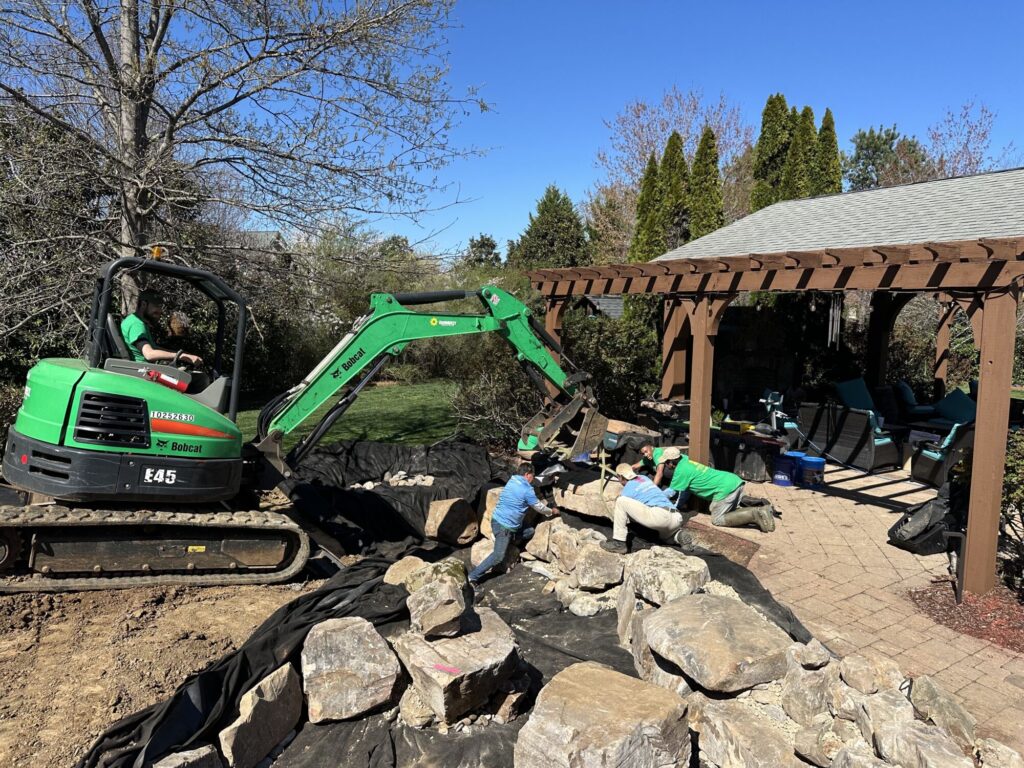
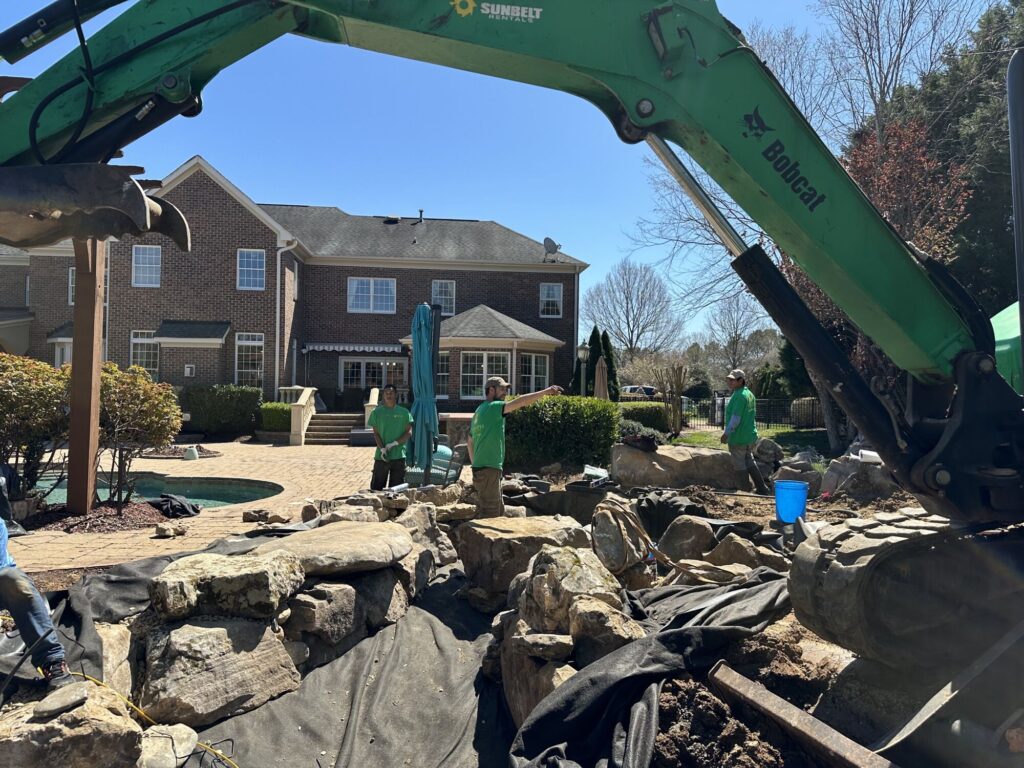
A Statue Finds Her Place
This pond build in Marvin, NC started as a simple waterfall feature, but as the project began to take shape, a new opportunity presented itself. Robert, the homeowner, had a beautiful statue fountain of a woman pouring water from a bucket—originally brought over from Bangkok. The fountain had been leaking and wasn’t functioning properly, and it sat somewhat forgotten on the other side of the yard.
As the pond developed, we started talking about how that statue could become a focal point within the new water feature. After some back-and-forth, we decided to incorporate it into the design. Together, we chose a spot where she could be viewed from both the house and the pool area, giving her a new life and renewed presence in the landscape.
We did discuss liability with Robert—moving the statue came with risks, and with a firm handshake, we agreed that our team wouldn’t be held responsible if anything happened during the relocation. Thankfully, our crew carefully moved the statue across the yard and set her into place near the pond, where she looked like she had always belonged.
This unexpected addition became one of the most memorable parts of the project. It wasn’t something we planned from the start, but as the pond came to life, the idea to include the statue just felt right. It’s always rewarding when a project takes on a life of its own, and in this case, blending Robert’s statue into the pond created a unique feature that feels like it was meant to be there all along.
A Tree for Emelia
As the pond neared completion, we picked out a special Japanese maple to plant atop a small “mountain” in the landscape—a living tribute for Robert’s newborn daughter, Emelia. The idea was to create a space that would grow with her, adding both beauty and meaning to the pond’s design.
We surrounded the maple with soft ground covers and planted a few taller evergreens nearby to create a sense of privacy around the nearby seating boulders. It became a peaceful, intimate corner of the yard—perfect for sitting quietly by the water.
As Braeden finished the waterfall edging, the pond really started to come alive. With the sound of water flowing, the plants settling in, and this special tree in place, the space began to feel less like a project and more like a story unfolding in the landscape.
Scribing The Stone
To help tie the new koi pond into the existing patio, we picked out a special rock from the mountains with just the right character. The goal was to make it feel like the patio had been built around the pond—not the other way around—giving the space a sense of history and permanence.
We carefully set the boulder so it sat about two inches above the height of the surrounding pavers. This not only gave it a natural prominence, but also created an inviting spot where people could step off the patio and stand comfortably right at the pond’s edge.
To seamlessly integrate the stone, we popped and cut pavers to scribe around the boulder, making it feel like it had always been part of the space. It was a small detail with a big impact—bringing the two elements together in a clean, thoughtful way.
🐸 The New Pond Owners Joined Our Monthly VIP Service
After completing their beautiful new pond, the homeowners decided to become Monthly VIP Members. As part of this exclusive service, we’ll visit their property every month to check on water quality, trim plants, clean the pump, and ensure everything is looking and running exactly as it should. It’s the perfect way to protect their investment and keep their pond healthy and stunning year-round.
✅ Project Recap & Final Gallery
This pond project was a true success from start to finish. The homeowners were thrilled with the final result and couldn’t wait to enjoy their new outdoor space. We’re proud of how everything came together—from the natural rockwork to the clear, flowing water. Scroll down to view a gallery of the completed pond and see the transformation for yourself!
🌟 See More of Our Work
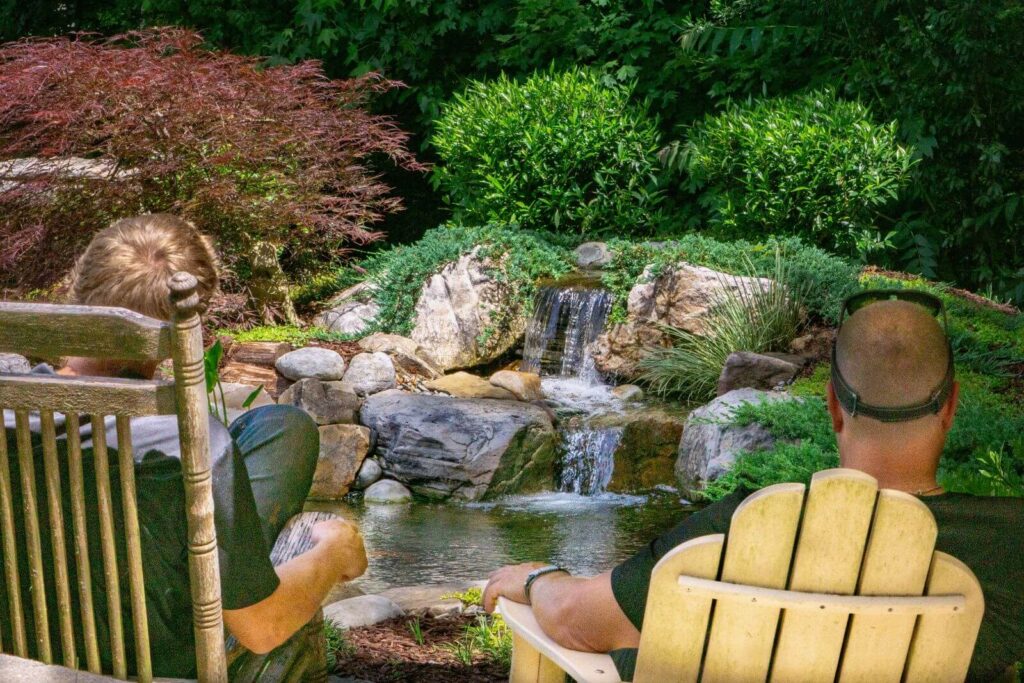
We love helping families create relaxing, natural spaces they can enjoy every day—and we stand behind every project long after the final rock is placed. If you’d like to see another one of our custom pond builds, check out this stunning koi pond we completed in Weddington, NC. It’s one of our favorite transformations!

